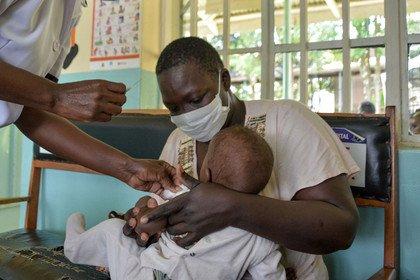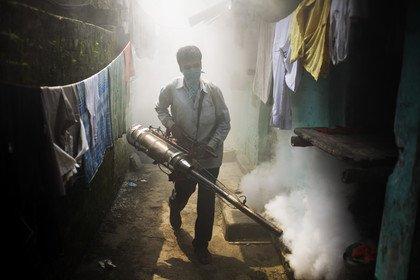
The mosquito breeder
Malaria research needs a steady supply of mosquitoes, and breeding them involves extreme self-sacrifice from the Shoklo Unit’s carer.
The worst thing about feeding hundreds of mosquitoes on your own blood is not the itching – if you do it enough times, your body gets used to the bites. It’s not even the pain, although it is always painful since the mosquitoes will use their snouts to root about your flesh in search of a blood vessel.
It is more that, sometimes, the little suckers take their time.
“They just walk around on your arm. You’re sitting there and thinking, ‘Seriously? I have things to do’,” says Chiara Andolina.
Andolina is an infectious-disease researcher who works at the Shoklo Malaria Research Unit, a world-renowned laboratory nestled in an unassuming town near Thai–Myanmar border. She runs the Unit’s insectory, where mosquitoes are bred, reared, infected with the Plasmodium parasites that cause malaria, and dissected.
There are only five or six such facilities in Thailand, largely because the malarial mosquitoes of South-east Asia are delicate, wilting flowers. In Africa, malaria is transmitted by Anopheles gambiae – a hardy insect with catholic tastes. They will go without food for days. They will endure through tough environmental conditions. They will suck blood from rabbits, cows... basically anything that they can get their proboscis into.
Their Asian cousins, Anopheles dirus, are very different. “You blow on them a little bit and they’re like: ‘No. I’m not mating today. I’m upset.’” They also refuse to eat anything except human blood, which is why Andolina has to feed them herself.
She does this simply by sticking her arm through a muslin sock and into their cages. It takes half an hour and she does it every four days. “They’re very spoiled,” she says.
Andolina fed around 600 mosquitoes yesterday and you wouldn’t be able to tell – her arm is free of any marks because she has built up resistance to the allergens in the mosquito saliva. Her boss, François Nosten, had to fill in for her two weeks ago and his arm is still covered in welts. This is why there is no feeding rota. It’s just Andolina. She has tried to convince her research assistants to help but, for some strange reason, they aren’t keen.
The boxes contain two closely related species of mosquito: Anopheles dirus B and C. The two colonies have to be kept apart. If someone mixes them by mistake, it would be nigh impossible to fix the error. B and C look identical, even under the microscope, and only their genes reveal them to be distinct species. They also transmit very different malarial parasites: B carries Plasmodium falciparum, the main cause of malaria in these parts, while C transmits P. vivax. Andolina once spent a few years on an experiment that just wouldn’t work, because she was trying to infect one of the species with the wrong parasite.
Only female mosquitoes drink blood, and they use proteins in their meals to make the shells of their eggs. But they also need mating partners, and A. dirus are as finicky about sex as they are about food. Andolina used to have to force-mate them.
To begin: decapitate a male, and anaesthetise a female with ether. Next, unite the two by inserting the male’s still-protruding genitals into his unconscious partner. Get it right and the two insects (or one-and-a-half insects) lock together, sperm is transferred, and the female becomes pregnant. Andolina first learned to do this without a microscope. It took steady hands.
The females lay their eggs as little floating rafts. It takes two days for these to hatch into larvae, which hang from the water’s surface, breathing from their rear ends and sweeping up passing debris with brush-like mouthparts. Andolina keeps them in a succession of trays, nourished with tropical fish food. She needs to change the water regularly, or the larvae quickly succumb to all manner of bacterial, viral and fungal infections. They are not the toughest of species.
It takes another two weeks for them to turn into adults. Now, they’re ready for experiments. Typically, this involves infecting them with malaria.
Andolina loads a feeding pump with blood samples from people with malaria. The pump delivers the blood into a grey cylinder, with a membrane stretched across it. She places this on top of a sheet of muslin, draped over an empty noodle cup containing dozens of mosquitoes. The cylinder is like an upside-down feeding trough. The mosquitoes dangle upside-down from the muslin, pierce the adjacent membrane, and suck up the blood.
Once they are infected, security is paramount. The law dictates that there must be four doors between them and the outside world, so they’re kept inside an incubator within one of three adjoining rooms. Andolina counts them every day to make sure that none have escaped. If she ever misses one – and that hasn’t happened yet – she won’t be allowed to leave the lab until she has found and killed it.
“I don’t do it because I love mosquitoes,” says Andolina. Her work creates a ready supply of parasites. She provides these to collaborators in Paris and Singapore, who are trying to develop new drugs that target malarial parasites holding out in a patient’s liver.
More directly, she wants to see if a drug called primaquine can help to break the cycle of malaria transmission. The drug kills malarial parasites in the liver, but there’s a chance that it could also stop the mosquitoes from becoming infected. Andolina wants to see if mosquitoes are less likely to pick up the parasites after feeding on the blood of patients who have taken low doses of primaquine.
At high doses, the drug produces nasty side-effects in some patients. If lower doses are still effective, then primaquine could feature in the Shoklo Unit’s radical campaign to completely eliminate malaria from South-east Asia, by treating as many people as possible with antimalarial drugs.
This article first appeared on Mosaic.
